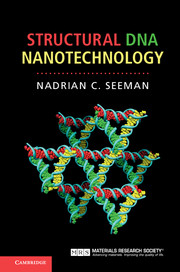Book contents
- Frontmatter
- Contents
- Preface
- 1 The origin of structural DNA nanotechnology
- 2 The design of DNA sequences for branched systems
- 3 Motif design based on reciprocal exchange
- 4 Single-stranded DNA topology and motif design
- 5 Experimental techniques
- 6 A short historical interlude: the search for robust DNA motifs
- 7 Combining DNA motifs into larger multi-component constructs
- 8 DNA nanomechanical devices
- 9 DNA origami and DNA bricks
- 10 Combining structure and motion
- 11 Self-replicating systems
- 12 Computing with DNA
- 13 Not just plain vanilla DNA nanotechnology: other pairings, other backbones
- 14 DNA nanotechnology organizing other materials
- Afterword
- Index
- References
4 - Single-stranded DNA topology and motif design
Published online by Cambridge University Press: 05 December 2015
- Frontmatter
- Contents
- Preface
- 1 The origin of structural DNA nanotechnology
- 2 The design of DNA sequences for branched systems
- 3 Motif design based on reciprocal exchange
- 4 Single-stranded DNA topology and motif design
- 5 Experimental techniques
- 6 A short historical interlude: the search for robust DNA motifs
- 7 Combining DNA motifs into larger multi-component constructs
- 8 DNA nanomechanical devices
- 9 DNA origami and DNA bricks
- 10 Combining structure and motion
- 11 Self-replicating systems
- 12 Computing with DNA
- 13 Not just plain vanilla DNA nanotechnology: other pairings, other backbones
- 14 DNA nanotechnology organizing other materials
- Afterword
- Index
- References
Summary
Let's look again at the molecule shown in Figure 3-5a. It looks like a cube built of DNA. However, as we noted earlier, the molecular geometry has really not been characterized, because the 3-arm junctions on its vertices are floppy units. Thus, it could look as we have drawn it, or it could look like a rhombohedron (a cube-like structure where one of the body diagonals has been stretched or squashed somewhat). The things we can say for sure about the molecule are that each of the edges is two turns long (the sequence was designed that way) and that each face of the object corresponds to a cyclic single strand of DNA. For example, the front face corresponds to the red strand. Because DNA is a double helix, every turn of the double helix results in the strands being interwound. Since each edge is two turns long, that means that the red strand is linked twice to the four strands of the four faces that flank the front: the green strand on the right, the cyan strand on top, the magenta strand on the left, and the dark-blue strand on the bottom. It is only indirectly linked to the yellow strand at the back. When cyclic molecules are linked together like the links of a chain, they form what is known as a catenane. Of course the hexacatenane corresponding to the cube is a much more complex object than just a simple chain. The molecule in Figure 3-5b, with the connectivity of a truncated octahedron, is a 14-catenane. It is even more complex than the cube-like molecule shown in Figure 3-5a.
Catenanes and knots. It turns out that catenanes are closely related to knots. This relationship is indicated in Figure 4-1. The upper left image is of a knot with five nodes and an arbitrary strand polarity. Look at the lower right node in this knot. It is made up of a strand that passes over another strand. You can think of it as four strands: the first half of the strand on top, connected to the second half of the strand on top, the first half of the strand on the bottom, connected to the second half of the strand on the bottom. Now, let's imagine breaking those connections, and reconnecting the strands so that we maintain the same polarity.
- Type
- Chapter
- Information
- Structural DNA Nanotechnology , pp. 44 - 63Publisher: Cambridge University PressPrint publication year: 2016



